History
The Rice Owl Band was formed by 12 students in 1916 and was built upon interest in band activities and the reading of band literature. The band increased to about 50 members when Lee Chatham became director in 1922. During this period, however, there were few high school bands, and so the main body of membership was supplied through civic or municipal bands and private teachers.
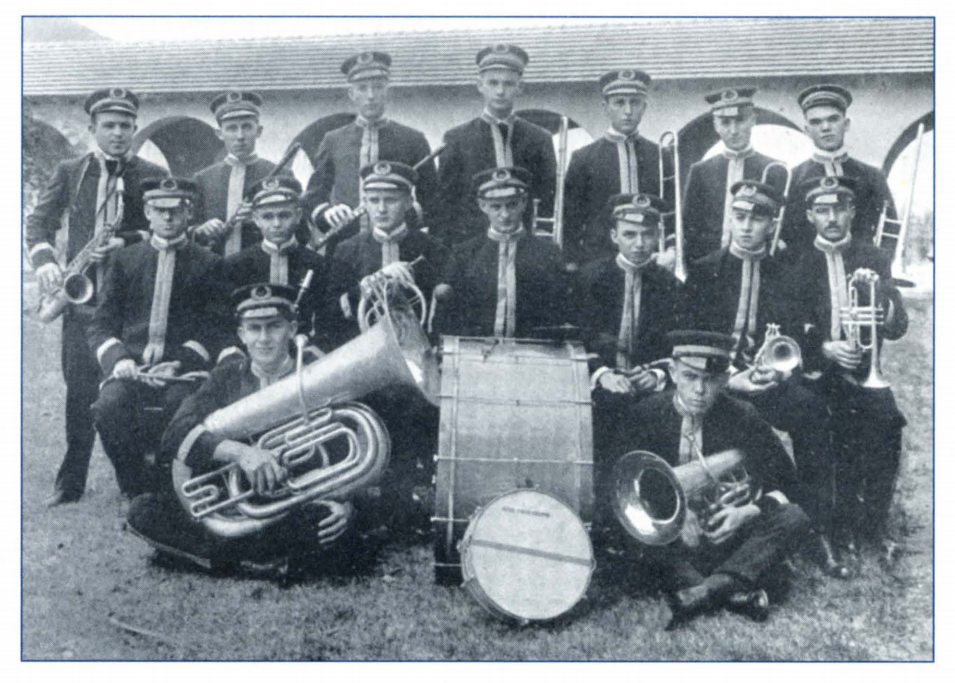
The Rice Band in 1916
Following Mr. Chatham’s retirement in 1938, Mr. Kit Reid became director. During the period of World War II, the supply of band personnel was very unstable, so toward the end of the war, Hugh Saye and Dick Kincheloe formed a band of Navy cadets under the V-12 program. This group was supplemented by civilians from the student body. After the war, the band was reorganized and the first women, four majorettes, were added to the previously all-male organization. Neel Cotton completed the academic year as director following Mr. Reid’s retirement in 1950.
In 1951, Holmes McNeely became director and instituted a building program of both equipment and personnel. Mr. McNeely was the first to offer a number of band scholarships to students involved with the Rice Owl Band. At this time, women musicians were added to the band for the first time. Upon the retirement of Mr. McNeely in 1967, Mr. Bert Roth took charge of the band activities. In the fall of 1968, every qualified member of the Rice Owl Band was given a work scholarship in recognition of their participation.
In 1970, the Rice Owl Band broke with tradition and introduced timely and sometimes controversial topics into their halftime activities. With their tongues firmly planted in their cheeks, the band parodied politics, life at Rice, and other members of the Southwest Conference, using the brains that Rice is famous for, rather than brawn. The band also gradually stopped marching at this time and began the “scattering” that it is now famous for. This type of entertainment proved popular with band members as well as with the student body.
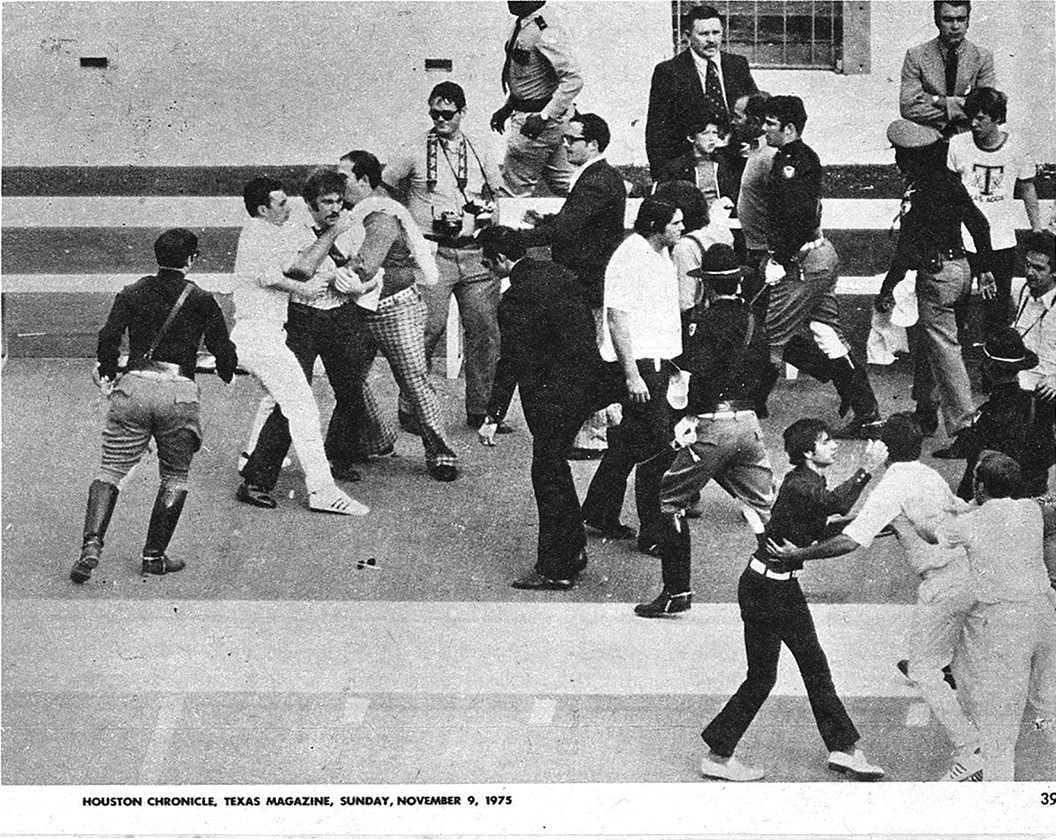
Angry A&M fans after the 1973 show
Dr. Ken Dye took over the director’s job in 1980. By emphasizing musical quality and contemporary show design, the band (now called the Marching Owl Band, or MOB) was able to entertain a larger audience. His first year marked the beginning of the jazz ensemble and the granting of credit for the concert band. In 1982, Dye updated the MOB’s uniforms, and the MOB donned their trademark gray felt fedoras for the very first time.
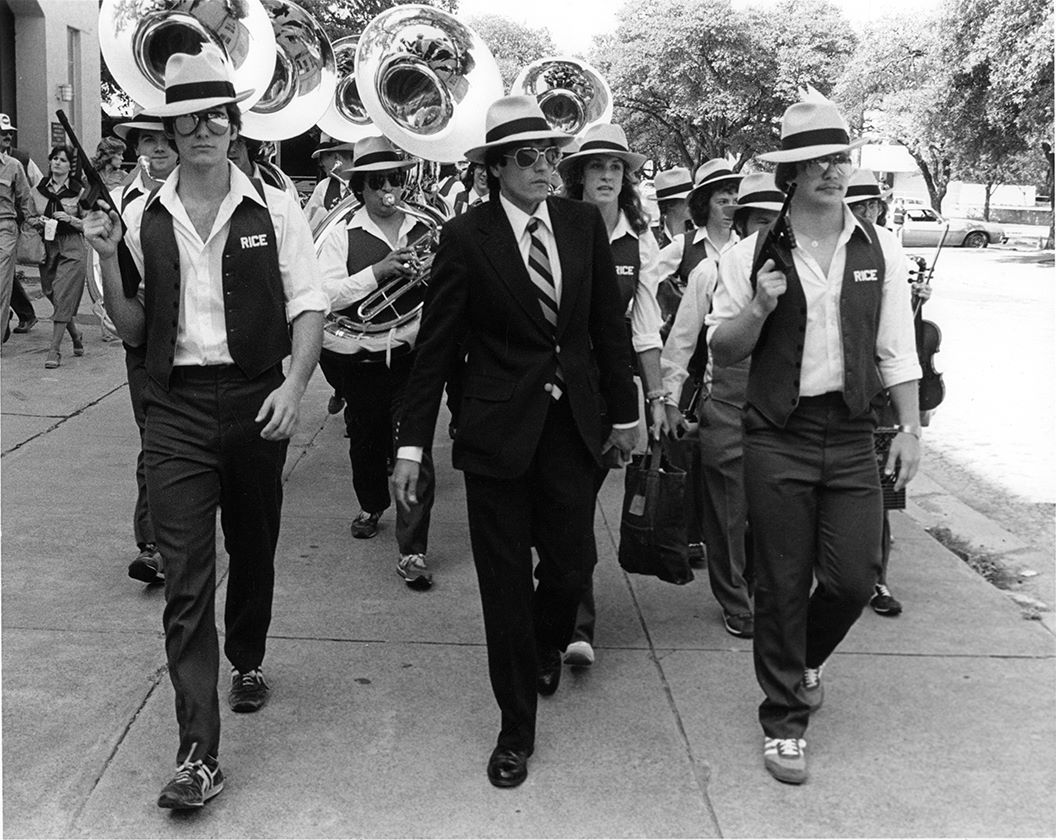
Ken Dye with the MOB
Dr. Dye’s tenure at Rice saw MOBsters perform at the Opening Ceremonies of the 1984 Olympics, the 1985 Presidential Inauguration, the 1986 Statue of Liberty Celebration and U.S. Olympic Festival, and the 1993 Carnivale in Nice, France. Dr. Dye believed that travel was an important part of any major college band. During his time as MOB director, the band took trips to places as far afield as Notre Dame and the campuses of all three U.S. Service Academies. The MOB also took shorter trips to SMU, TCU, and Tulane University.
Dr. Dye’s single greatest legacy lies with his tremendous talent for arranging music for bands. During his time at Rice, he arranged literally hundreds of tunes for the MOB to perform. Our music library overflows with his first-class arrangements of many rock, jazz, and blues standards. When it comes to playing great music, the MOB has long been among the best college bands in the country — a tradition that it will uphold for years to come.
In spring 1995, Willy’s Pub and the MOB Bandhall were destroyed in a fire that gutted much of the Rice Memorial Center. Luckily enough, however, the MOB was already planning a move to the newly-refurbished basement of the Campus Central Kitchen Building (now the OEDK). Although a new band hall was in place, the MOB had to rebuild from nearly zero — new instruments, equipment, office supplies, computers, and uniforms all had to be bought in the summer of 1995 in time for the 1995-96 season.
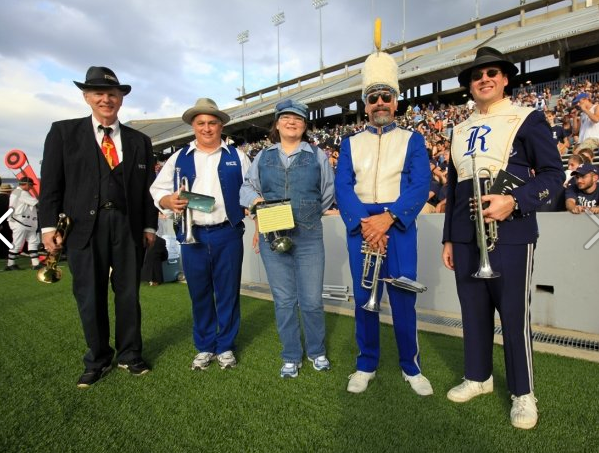
Evolution of MOB uniforms
In 1997, Dr. Dye left Rice to rebuild the band program at the State University of West Georgia, a position he held for only one year before moving on to a directorship at Notre Dame University in the fall of 1998. Mr. Sean Williams was hired in the summer of 1997 to serve the MOB and the Rice Band Department as interim director until a permanent replacement for Dye could be found. That replacement was Dr. Robert Cesario, who came to us in the fall of 1998 from Tulsa, OK. After four years, Dr. Cesario resigned from the position of Director of Rice Bands in the summer of 2002.
The MOB is currently under the leadership of Mr. Chuck Throckmorton, who has been with us since 2002.
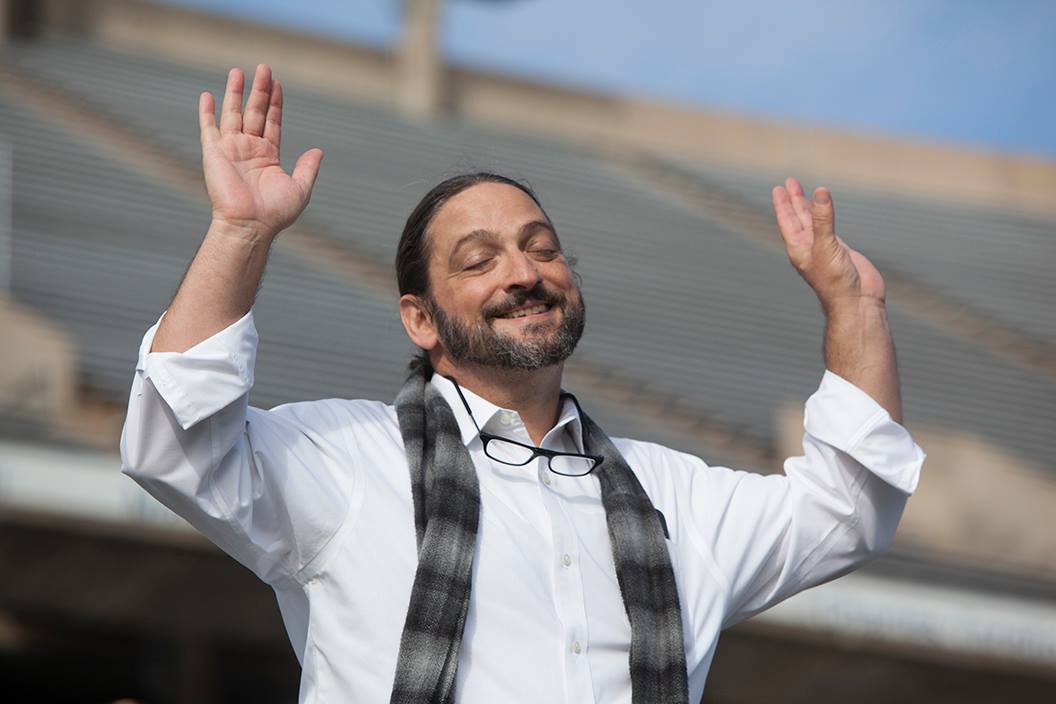
Chuck at a 2017 rehearsal
In spring 2017, the MOB moved into its new band hall on the south end of the football stadium, leaving its old shared location in a gym in the back of Tudor behind. The hall was officially named the John “Grungy” Gladu Band Hall in fall 2017.
School music
Rice’s Honor
“Rice’s Honor” was adapted from the “Our Director March” in the 1922, with lyrics by Ben H. Mitchell ’24. It served as Rice’s unofficial alma mater for 40 years before being officially established as such in the 1960s as such.
All for Rice’s honor, we will fight on.
We will be fighting when the day is done.
And when the dawn comes breaking,
We’ll be fighting on, Rice, for the Gray and Blue.
We will be loyal, to Rice be true.
Fight Song
The Rice Fight Song was written by Louis Girard ’41 and Harry Girard and premiered in 1940. Although originally intended to replace “Rice’s Honor” as the school’s alma mater, it was much more popular among students as a fight song, leaving “Rice’s Honor” in the role of alma mater.
Fight for Rice, Rice fight on,
Loyal sons arise.
The Blue and Gray for Rice today
Comes breaking through the skies.
Fight, fight, fight!
Stand and cheer, Vict’ry’s near,
Sammy leads the way.
Onward go! to crush the foe,
We’ll fight for Blue and Gray.
Bonnet
Bonnet was written in the ’60s by Harvin C. Moore ’27 and Barry Moore ’62 to the 1909 tune “Put on Your Old Grey Bonnet” and became a popular tune at football games.
30-second Bonnet is the tune compressed into 30 seconds and is performed at basketball games.
Louie Louie
“Louie Louie” is the MOB’s personal fight song/theme song based on the 1963 Kingsmen hit. The MOB first performed it in a show against TCU in 1981, and now plays it at every football game.


